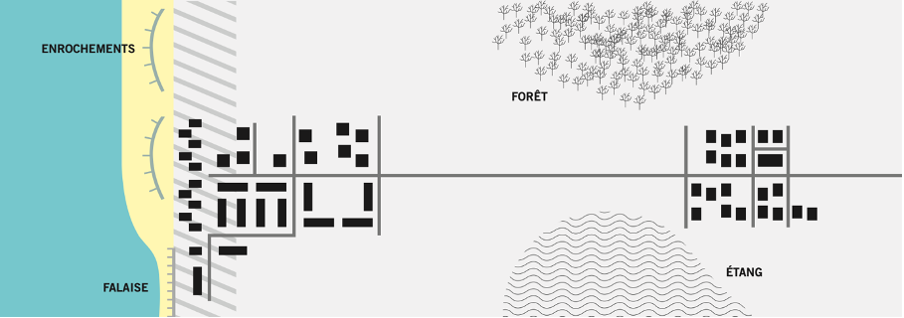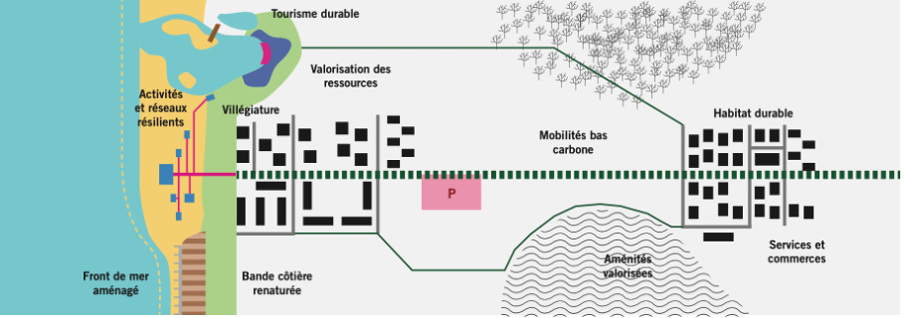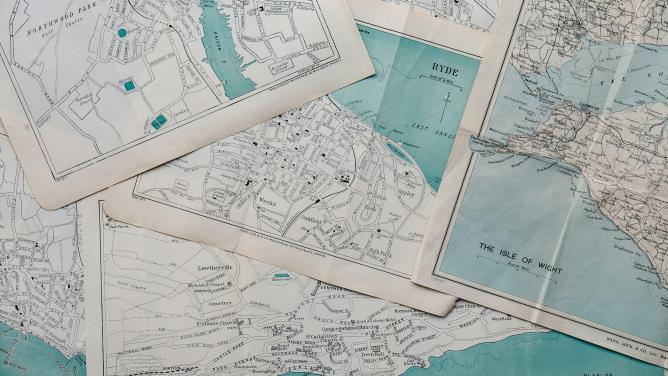Rising sea levels inevitable
As detailed in the latest IPCC report, the majority of the world’s population, economic activities and critical infrastructure are today concentrated near the sea. By 2050, one billion people are expected to be living in low-lying cities and settlements by the sea. The ability of these areas to adapt to the climate crisis is thus a major issue, economically, socially and culturally.
The scientific community is unanimous: sea levels will continue to rise in the coming years. Most debate currently focuses on the scale of the threat and the measures to be taken to limit its impact. Today, 5.5% of the world’s population is faced with the problem. Even by limiting global temperature increase to the target of the Paris agreement (1.5°C), some 500 million people would still be faced with the problem. Beyond rising sea levels, a higher frequency of extreme weather is also expected (a 100-fold increase with a warming of 1.5°, according to a study published in Nature). According to the OECD, the economic cost of residual damage linked to rising sea levels during the 21st century could amount to between $1,700 and $5,500 billion.
Reinforce, adapt, retreat: three ways to combat sea level rise
According to the IPCC, the approaches available for helping coastal communities adapt to rising sea levels fall into three main categories:
– Protection: this includes “hard” solutions like building defences, as well as dune restoration and beach nourishment or enhancing coastal vegetation.
– Accommodation: this includes adapting construction standards (especially concerning building height and foundations) and implementing emergency planning.
– Managed retreat: this solution is the most drastic and involves moving communities and infrastructure away from the coast, and avoiding new developments in such areas.
In the same vein, Leonard, with the Concorde Urban Planning Agency, has devised a dynamic shoreline scenario to propose a trajectory of public and private interventions that can implement a strategy for the long-term retreat and relocation of threatened assets. This trajectory unfolds in three major steps:
– Step 1: regulation, transfer of rights, land reserves
– Step 2: incentives, compensation, improvement
– Step 3: active relocation, new uses
Current situation : a coastline in mitigation of climatic hazards
Projected and proposed situation: a dynamic coastline in adaptation to climate hazards
Limitation of dykes
Protection measure par excellence, dykes have many advantages: Take Saint-Malo, whose breakwaters have been protecting the city for decades. Then there’s the 17,500km of dykes in the Netherlands which have certainly proven their worth. Meanwhile, New York City has embarked on a $1.45 billion resiliency project to protect Manhattan. And finally, the EU-funded DURCWAVE project aims to invent more high-performance coastal defence mechanisms, proving that there is still keen interest in coastal walls.
However, there are other projects which have not had the same success, such as the MOSE mobile dike system intended to protect Venice. Broadly speaking, constantly raising dyke heights will eventually have to face the highest sea-level hypothesis (2.4m by 2100), which poses technical limitations such as safety issues.
Proven natural infrastructure
The most promising infrastructure for combating rising sea levels are undoubtedly those inspired by nature itself. Take sponge cities, which are particularly popular in China. The concept is designed to provide urban areas with the ability to naturally absorb water. The city of Wuhan, now famous for other reasons, has benefited from a €1.4 billion investment to make permeable pavements and develop wetlands.
Restoring vegetation has also proven to be a time-tested technique: in Kisakasaka in Tanzania, mangrove restoration has helped to protect crops, just as coral reef preservation helps protects coastal cities.
A combination of nature-based solutions and grey infrastructure is proving successful. Take these coral reef solutions: Coralive’s metal structures use mineral accretion technology in the Maldives, meanwhile X-Reef has created 3D-printed artificial reefs made from concrete in the Calanques. In Canada, the city of Surrey (coastal floodplains make up about 20% of Surrey’s entire land area) has also decided to combine natural and technical solutions. The former involves creating parks and focusing on local ecosystems, meanwhile the latter involves developing dykes, replacing bridges and installing storm sewers.
Whether the solution is artificial or natural, the Sea’ties project, led by the Ocean & Climate Platform, has created a shared forum mapping and listing 89 different coastal adaptation projects which tackle rising sea levels around the world.
The Maldives: a life-size experiment
To fight against rising sea levels, the Maldives (80% of the archipelago is less than 1m above sea levels) have opted for a radical solution: construct artificial islands by dredging millions of tons sand. The island of Hulhumalé, whose construction began in 1997, now has 50,000 inhabitants. Floating solutions are also favoured by the archipelago, which looked to the Dutch firm Dutch Dockland to build 5,000 houses in the heart of the atolls.
Simulate to anticipate
In Caen, France, a wave flume is used to simulate the impact of waves on coastal infrastructure. Housed inside the École supérieure d’ingénieurs des travaux de la construction de Caen (ESITC), it has proven particularly useful in anticipating the impact of rising sea levels. Note that one of the largest infrastructures of this type is currently located in Delft in the Netherlands and can create waves of 4.5m.
Again, in the interests of anticipation, digital simulation solutions make it easier to manage infrastructure. Take Carapace, a project accelerated at Leonard, which is a fine example of point clouds and 3D recognition in action. Photogrammetry, LiDAR and multibeam bathymetric technology are used for high-precision dyke reliability modelling and monitoring.
The internet is drowning
The digital world is based on real life infrastructures, which are also threatened by rising sea levels. According to a study carried out at the University of Wisconsin, more than 4,000 miles of fibre optic cable are under threat in the not so distant future (20 years). It’s a serious risk for connectivity which calls for an infrastructure overhaul, as well as serious consideration concerning data transfer in the event of a disaster.
While at the centre of economic, climatic and social challenges and already largely affected by climate change, coastal areas act as an ideal ‘lab’ experiment for measuring our ability to quickly pivot towards resilient development models.
This article was published as part of the Leonard newsletter. Subscribe to receive future ones by following this link.


